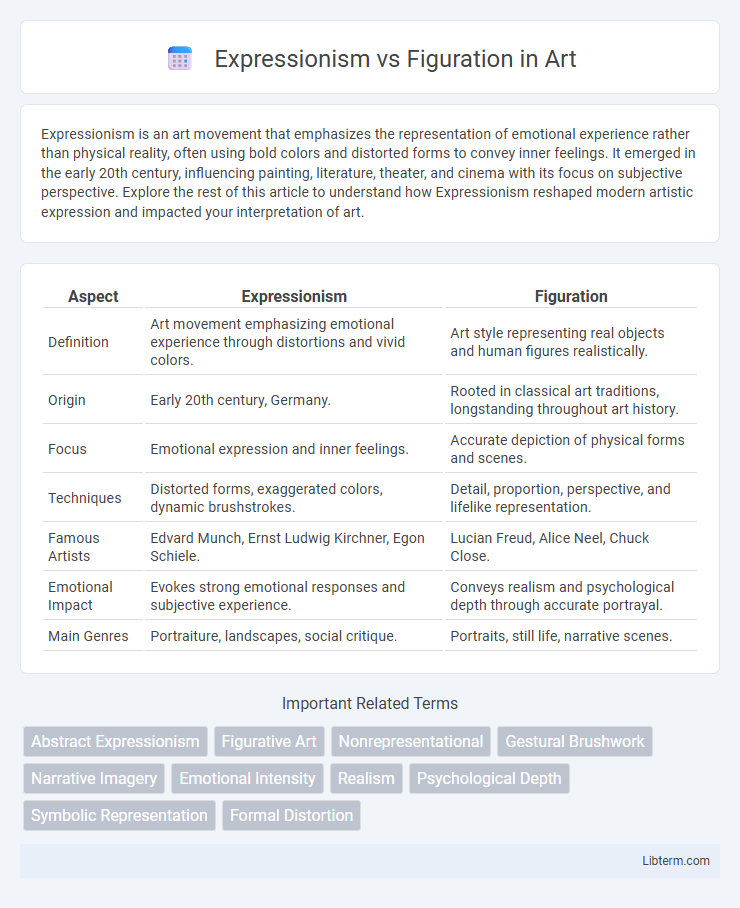Expressionism is an art movement that emphasizes the representation of emotional experience rather than physical reality, often using bold colors and distorted forms to convey inner feelings. It emerged in the early 20th century, influencing painting, literature, theater, and cinema with its focus on subjective perspective. Explore the rest of this article to understand how Expressionism reshaped modern artistic expression and impacted your interpretation of art.
Table of Comparison
| Aspect | Expressionism | Figuration |
|---|---|---|
| Definition | Art movement emphasizing emotional experience through distortions and vivid colors. | Art style representing real objects and human figures realistically. |
| Origin | Early 20th century, Germany. | Rooted in classical art traditions, longstanding throughout art history. |
| Focus | Emotional expression and inner feelings. | Accurate depiction of physical forms and scenes. |
| Techniques | Distorted forms, exaggerated colors, dynamic brushstrokes. | Detail, proportion, perspective, and lifelike representation. |
| Famous Artists | Edvard Munch, Ernst Ludwig Kirchner, Egon Schiele. | Lucian Freud, Alice Neel, Chuck Close. |
| Emotional Impact | Evokes strong emotional responses and subjective experience. | Conveys realism and psychological depth through accurate portrayal. |
| Main Genres | Portraiture, landscapes, social critique. | Portraits, still life, narrative scenes. |
Understanding Expressionism: Core Principles
Expressionism emphasizes emotional experience over physical reality, capturing subjective feelings through distorted forms and vivid colors to evoke intense responses. This art movement prioritizes inner turmoil and psychological depth, rejecting naturalistic representation typical in Figuration. Key principles include the use of exaggerated imagery and symbolic content to convey existential angst and human emotion.
Defining Figuration in Art
Figuration in art refers to the representation of real-world objects, particularly the human form, in a recognizable and often realistic manner. It contrasts with Expressionism, which emphasizes emotional experience and abstraction over accurate depiction. Figuration prioritizes clarity and identifiable imagery, making it a key concept in understanding representational art.
Historical Origins: Expressionism and Figuration
Expressionism originated in early 20th-century Europe, particularly Germany, as a reaction against realism and impressionism, emphasizing emotional experience through distorted forms and bold colors. Figuration, rooted in classical art traditions, focuses on depicting recognizable subjects and human forms with an emphasis on accuracy and detail. The historical origins of Expressionism mark a shift toward subjective interpretation, while Figuration maintains a connection to representational art.
Key Artists of Expressionism
Expressionism emerged as a powerful art movement characterized by exaggerated forms and vivid colors to evoke emotional responses, with key artists including Edvard Munch, known for "The Scream," Egon Schiele, famous for his intense and raw figure drawings, and Ernst Ludwig Kirchner, a leading figure in German Expressionism. These artists emphasized subjective experience over realistic representation, contrasting sharply with Figuration, which centers on accurate, often idealized depictions of the human form and environment. Expressionism's distortion and emotional intensity underscore a departure from the precise and objective qualities that define Figuration.
Influential Figurative Painters
Influential figurative painters such as Lucian Freud and Francis Bacon reshaped Expressionism by emphasizing raw human emotion and distorted realism, merging psychological depth with intense brushwork. Their works contrast with abstract expressionists by maintaining identifiable subjects while exploring inner turmoil and existential themes. This fusion of human form and expressive technique highlights the enduring impact of figuration within modern art movements.
Techniques and Visual Language
Expressionism employs bold, distorted forms and exaggerated brushstrokes to evoke intense emotional responses, often prioritizing subjective experience over realistic representation. Figuration emphasizes recognizable, anatomically accurate subjects and clear spatial depth, using controlled techniques to depict the human figure and everyday scenes realistically. Both movements use color and composition strategically; Expressionism favors vivid, non-naturalistic palettes to convey mood, while Figuration maintains naturalistic colors and balanced perspectives to enhance visual clarity.
Emotional Impact: Expressionism vs Figuration
Expressionism emphasizes intense emotional impact through distorted forms and vivid colors to evoke subjective feelings, creating a visceral connection with the viewer. Figuration relies on realistic representation and recognizable subjects, facilitating emotional resonance via relatable human expressions and narratives. The emotional power in Expressionism stems from abstraction and exaggeration, whereas Figuration evokes empathy through identifiable imagery.
Subject Matter and Symbolism
Expressionism emphasizes emotional experience and subjective interpretation, often distorting reality to convey intense feelings and inner turmoil. Figuration centers on recognizable subjects and realistic representation, using symbolism more literally to communicate specific narratives or cultural themes. Both styles use subject matter to evoke meaning, but Expressionism prioritizes psychological depth while Figuration highlights clarity and direct symbolism.
Contemporary Trends and Crossovers
Contemporary Expressionism emphasizes emotional intensity and abstract forms, often blending with figuration to create hybrid artworks that challenge traditional boundaries. Figuration in modern art incorporates expressive techniques, enhancing narrative depth and emotional resonance while maintaining recognizable subjects. Crossovers between Expressionism and Figuration manifest in dynamic compositions that leverage color, gesture, and form to explore identity, memory, and social themes in innovative ways.
Expressionism vs Figuration: Which Resonates Today?
Expressionism prioritizes emotional intensity and subjective experience through distorted forms and vivid colors, while figuration emphasizes recognizable, realistic depictions of the human form and everyday life. Contemporary art trends show a resurgence of figuration, driven by a desire for narrative and social commentary, yet Expressionism remains influential in abstract and emotive art practices. The ongoing dialogue between these styles reflects a balance between personal expression and representational clarity that continues to resonate in today's diverse art landscape.
Expressionism Infographic

 libterm.com
libterm.com